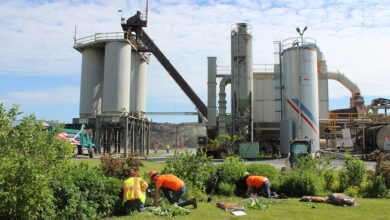Using Liquified Natural Gas to Lower Fuel Costs

OPERATIONAL TIPS: THE ROAD FORWARD TO LOWER EMISSIONS AND HIGHER PROFITS
Over the next several decades, reducing carbon emissions will be the industry’s foremost imperative, persisting even amid changing political and economic situations. Aiming to be net zero by 2050 seems daunting, but existing technologies and best practices can support our path forward.
As detailed in NAPA’s Greenhouse Gas (GHG) Emissions Inventory, technologies and practices already exist to help the industry toward its net zero carbon emissions goal. One opportunity is increasing use of natural gas as a burner fuel.
In 2019, the average blend of fuels consumed by U.S. asphalt mix producers was:

Asphalt Plants & Natural Gas
The asphalt pavement industry uses clean-burning natural gas at a higher rate than similar U.S. manufacturing industries. Asphalt mix plants can burn a variety of fuels, but the most common are natural gas, used oil, propane, and diesel fuel. In 2019, the average blend of fuels consumed by U.S. asphalt mix producers was natural gas (69.5%), diesel fuel (13.6%), used oil (10.2%) propane (HGL) (5.1%), and residual fuel oil (1.7%) (Shacat et al., 2022).
The industry’s use of natural gas is logical because of an abundant supply. The United States is the world’s largest producer of natural gas, making it a low-cost, abundant fuel source. Natural gas supplies about 33% of domestic energy used for heating/electricity via pipelines. When natural gas is not available, asphalt mix plants typically burn used oil or diesel fuel. However, there is a growing market for liquid natural gas (LNG), which can be easily transported to asphalt mix plants by truck (Johns, 2019).

LNG & Asphalt Contractors
LNG can be used in locations where delivery of natural gas by pipeline is not available. LNG is natural gas that has been cooled to a liquid state, making it easy to be stored and shipped to the plant, where a vaporizer returns the LNG to its gaseous state prior to combustion.
E.T. Simonds Materials Co. of Carbondale, Ill., partnered with Kinetrex Energy of Indianapolis to provide LNG storage and regasification equipment, installation, and maintenance to E.T. Simonds’ asphalt mix plant. The goal of the partnership was to reduce delivered fuel price, obtain a cleaner fuel, and reduce operational and maintenance costs.
Using LNG, E.T. Simonds saved substantially. Scott Robertson, Operations Manager, stated, “We were able to save over 35% on our fuel costs with Kinetrex, which allowed us to be more competitive on bids and win more business while also improving margins.” While saving costs, LNG is also a cleaner burning fuel than the diesel oil that E.T. Simonds had historically used—reducing both maintenance costs and emissions. In fact, LNG produces 6-11% fewer GHG emissions over diesel on a well-to-wheel basis (NGV America, 2018).
The Future
Looking ahead, increasing the use of natural gas to offset other fuel sources is one viable pathway to reduce emissions associated with burners. Not only is the use of natural gas cost-effective, but it can also help reduce the industry’s carbon footprint.
***
Johns, S. (2019). Switching to LNG Can Simplify Life for Asphalt Manufacturers. Asphalt Contractor. www.ForConstructionPros.com/asphalt/plants/article/21033058/switching-to-lng-cansimplify-life-for-asphalt-manufacturers.
NGV America. (2018). Fleets Run Cleaner on Natural Gas: Emissions and Environmental Benefits of Natural Gas Vehicles. https://afdc.energy.gov/files/u/publication/NGVAmerica-White-Paper-Fleets-Run-Cleaner-on-Natural-Gas_V2.pdf?3433629460
Shacat, J., Willis, J.R., Ciavola, B. (2022). GHG Emissions Inventory for Asphalt Mix Production in the United States: Current Industry Practices and Opportunities to Reduce Future Emissions (SIP 106). National Asphalt Pavement Association. www.AsphaltPavement.org/climate/research-best-practices.


